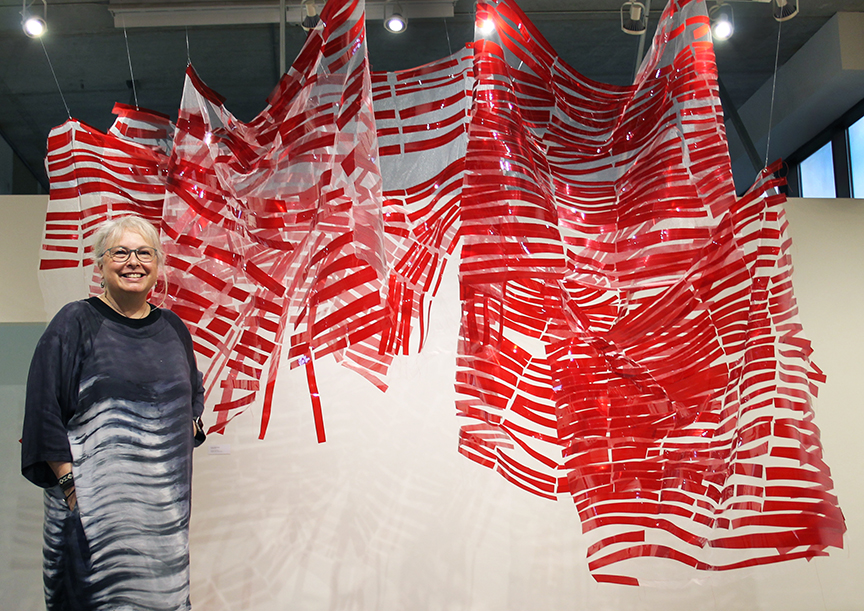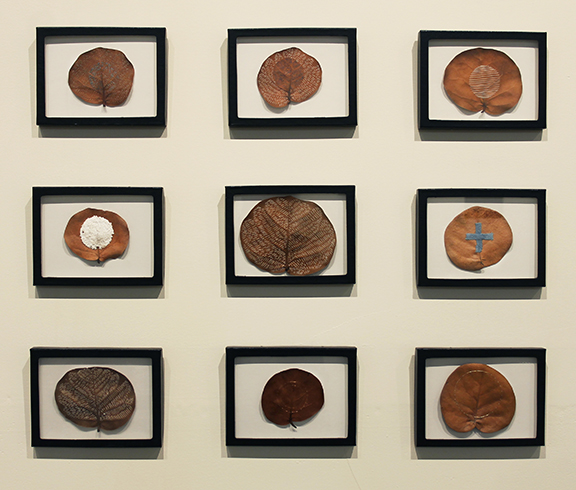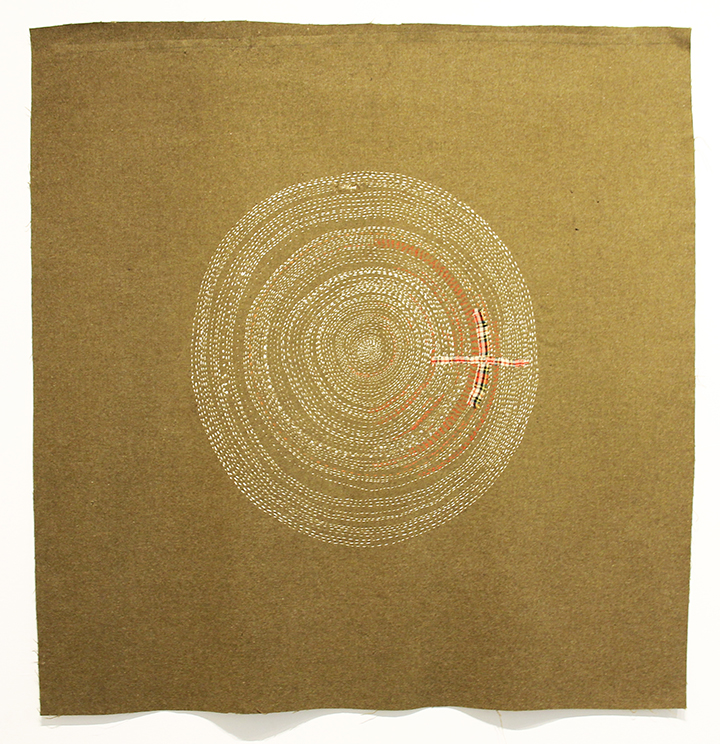Artist transitions from small works to large installations

Ohio artist Christine Mauersberger discovered her love of fiber arts in 1977, when the then 17-year-old toured “Fiberworks,” an exhibition of 49 textile artists at The Cleveland Museum of Art. It was one of the first contemporary fiber arts exhibits to be held in a major art museum.
“I saw the large-scale artworks of 49 international contemporary fiber artists,” she said. “Each was considered a pioneer in the growth of textiles as a medium for artistic expression. I was mesmerized by each piece and dazzled by the prospects of what I could achieve in my work.”
The results of that discovery can be seen in the Schweinfurth Art Center’s Davis Family Gallery in Mauersberger’s exhibition, “Marks Made,” which is on display through Jan. 9, 2022. Her artwork, which ranges from small, hand-stitched pieces to room-sized hanging installations, fills the gallery.
“My work has evolved from drawing and sewing small works to designing and executing large permanent installations,” she said. “I see a continuation in working in the same vein. Making small works are happy moments for me. They allow me to finish something with relative ease while concurrently working on larger pieces.”

Mauersberger’s journey to full-time artist didn’t start immediately after seeing “Fiberworks.” Instead, she spent 20 years working in the financial field while taking classes at night and on weekends.
“Throughout my post-graduate years, I continued to take specialized classes in lacemaking, quilting, printmaking, and drawing,” she recalled. “I didn’t know how to make the leap from working for someone else to working for myself. As I think back to that time, I now know that fear is what kept me from moving towards my goal as an artist.”
She finally quit at the end of 2009 to devote herself full time to her art.
With all her work, no matter its size, Mauersberger begins with thinking and drawing. “Each work is planned out for logistical purposes,” she said. “I use my drawing as a thinking process, then I consider the tools I will use to create the outcome I have visualized.”
When her piece will be hand sewn, she doodles ideas or reviews past marks, then decide on the material – paper or fabric – and thread. “I think about what makes me happy, and which material I want to spend time with; a material that feels good, looks nice, and inspires my sense of well-being,” she said.
There are some instances when Mauersberger stitches without a plan, usually when she is in extreme emotional distress. “For instance, when a loved-one has died, I am filled with such grief that I can only express and sooth my interior space with stitch,” she explained. “In these moments, my hands work in complete concert with my brain, transferring thoughts onto fabric through stitch.”

Her piece “Safe and Warm,” made after her father died, is one example. She found what seemed like an old army blanket in a thrift store that was the color of old, woolen Boy Scout uniforms. She stitched a circle in the center, and incorporated a cross made from an old scarf that her father inherited from his former Scoutmaster. Making it was Mauersberger’s way of working through her grief.
All of her hand-stitched pieces are made from personal experiences, whether sad or happy, so they are never for sale. However, Mauersberger is happy to make commissioned artwork, especially large-scale installations. “My fear falls by the wayside when I step into this arena,” she said.
For a recent large-scale commission for the Moxy Hotel in Columbus, Ohio, the client wanted her to use blue jeans, belts, zippers, and other materials to evoke the fashion industry, but said the work should not look like clothes. The hotel was located in the region of the country where many fashion designers work.
“I used a 3-D raster computer program to create multi-layered drawings and present the design,” she said. “‘Wrapped’ is the largest textile work I’ve ever made.”
Mauersberger’s installation “Timelines,” which fills a corner of the Davis Family Gallery, actually began as a smaller piece she made following the Aug. 16, 2012, death of her mother.
“I was never so sad in my life,” she said. “Concurrently, I also knew that I wanted to move away from small hand-stitched pieces into 3-D work.”
In her mind, she heard the frequent admonition of her mother: “If you think of it, do it.” So Mauersberger did it. “In my studio, I had this material called Rubylith. In a moment of inspiration, I thought, what if I cut the Rubylith into strips and sewed it to tulle? Then hung it so the lines would appear to float?”
Within two weeks, she had created a small, 8-foot-wide piece that, along with 11 other artworks, earned her the Ohio Arts Council Award of Individual Excellence and a Creative Workforce Fellowship in Cuyahoga County, Ohio.
That was when Mauersberger believes she became a professional artist. “After that, I started my website, I started reaching out to other artists,” she said. In 2016, she began teaching, including a recently completed stitching workshop at the Schweinfurth.
She later expanded the concept of her floating lines into “Timelines.” “After I made it, I thought, wouldn’t it be great if you could walk around it and enjoy it?” she said. “It’s so simple. It’s meant to be joyful and happy.”
That’s how Mauersberger describes her life now. “I waited my whole life for this,” she said. “I worked, knowing that there was something else I should be doing. I don’t want to be doing anything that doesn’t make me happy.”
The Schweinfurth Art Center’s programs are made possible by the New York State Council on the Arts with the support of the Office of the Governor and the New York State Legislature.
